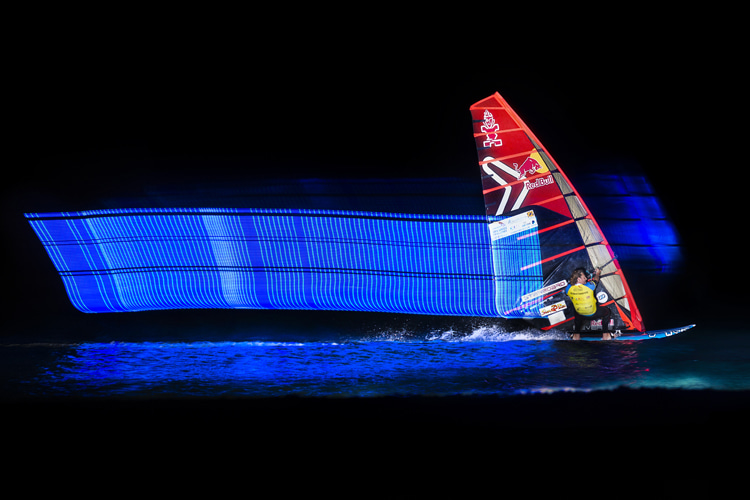Speed sailing is all about who is the fastest man and woman on the block.
In February of 1990, the Frenchman Pascal Maka set an outright speed sailing record of 38.86 knots - a windsurfer was the fastest sailor on the water for the first time.
I spoke with Erik Beale, at home in Hawaii, the first windsurfer to crack 35 knots and the first sailor of any craft to break through the 40 knots barrier.
Erik's description of a crash illustrated the forces involved in speed sailing most graphically:
"The rocker line of my board at the time was too straight, and I got pitched at 40 knots. From being fully in control and sailing, I hit the water in not even 2/10 of a second."
"It was like being hit by a barn door at 50 miles per hour. It hit me so hard that the impact tried to pull my vertebrae through my stomach and out the front, tearing all the muscles in my back and requiring three months of re-education."
"They dragged me out of the water, and I thought I was paralyzed."
"The rig had disintegrated, everything had broken, the spreader bar of my harness was sheared in half, and the webbing was pulled out."
"The boom was broken in three places, and the mast was broken. The sail was actually okay, as once everything broke, the sail just sort of went floppy."
I wondered if speed sailors wore any type of protection for this kind of abuse. Erik told me that he felt the only real protection was flexibility.
"I try to do a lot of stretching and yoga because that is the only thing that will stop you from hurting yourself when you hit."
"If you are like a piece of rubber, then you won't get hurt, but if you're stiff and your muscles are tight, then you tear things, you break things."
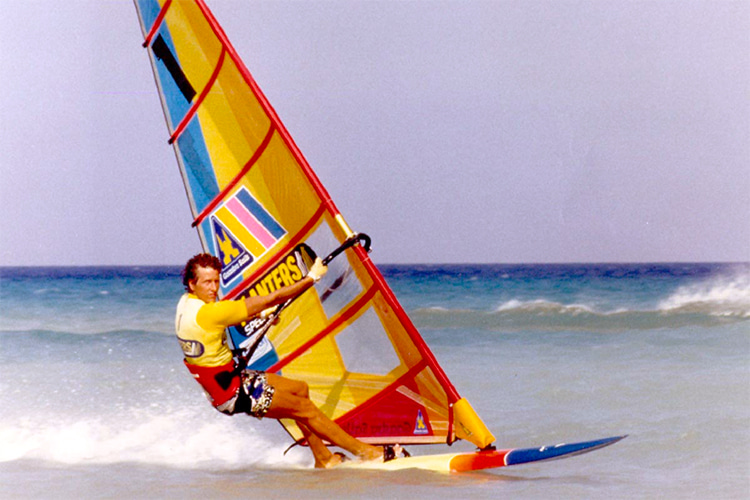
The History of Speed Sailing
The sport has grown from its beginnings in Weymouth, England, where since 1972, the Royal Yachting Association's (RYA) annual speed week has attracted an amazing assortment of sailing craft.
The fastest and one of the most exotic boats in those days was the Crossbow, a very long, thin proa which, after four years of development, reached 31.10 knots.
It was later replaced by Crossbow II, a staggered biplane catamaran.
This boat, owned by Timothy Colman, reached 36.06 knots and was retired as the undisputed champion in 1980.
At first, windsurfers were regarded as nothing more than beach toys in the speed sailing world, but people started to take notice when, in 1979, Dutchman Derk Thijs set a record in the 10 square meters (108 square foot) class with a then incredible 19.1 knots on a modified Windglider with neither harness nor footstraps.
World Records
World records need to be ratified to be official.
This means that not only do you have to be the fastest, but you must prove it on an official course in front of trained witnesses.
The World Sailing Speed Record Council (WSSRC), which has been affiliated with World Sailing since 1989, provides commissioners for this purpose.
The Council makes and maintains rules for speed sailing. It examines, ratifies, and publishes record claims.
They also will help and advise organizers of record attempts.
A qualified surveyor must measure the course, normally using electronic instruments, to ensure that it is the official 500 meters (1,640 feet) distance.
Setting a world record is an expensive proposition.
Not only do you have all the expenses of equipment, travel, and accommodation, but also course setters, timers, and commissioners must be paid for.
There is no guarantee of wind on any particular day, either; it may be necessary to wait weeks or even months for the right conditions.
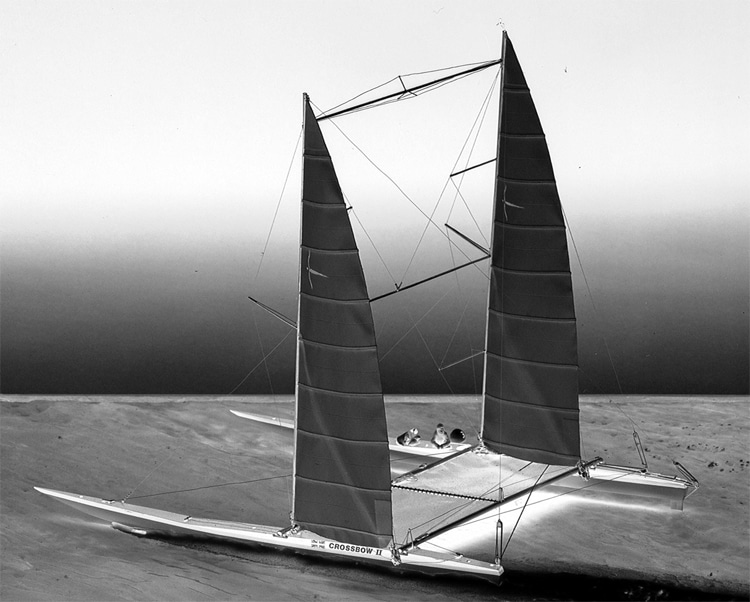
Timing World Records
Records were originally timed by hand.
Eight timers would simultaneously start their watches in response to the shout of "Now!" from an observer in a small boat.
In the past, a videocassette recorder (VCR), incorporating sophisticated timing devices that generated a clock image on the screen, received the images from the cameras, and a computer calculated all the speeds and sorted them in order.
Electronic timing systems, with photocells or press buttons to signal starts and finishes, were also used as a backup.
New timing systems relying on video cameras and GPS devices are highly accurate.
Speed Courses
Speed trials can be held anywhere there is windsurfing.
To have a chance of making a world record, a steady wind of at least 40 knots is needed, and flat water is essential.
The ideal spot will have an unobstructed fetch and no current.
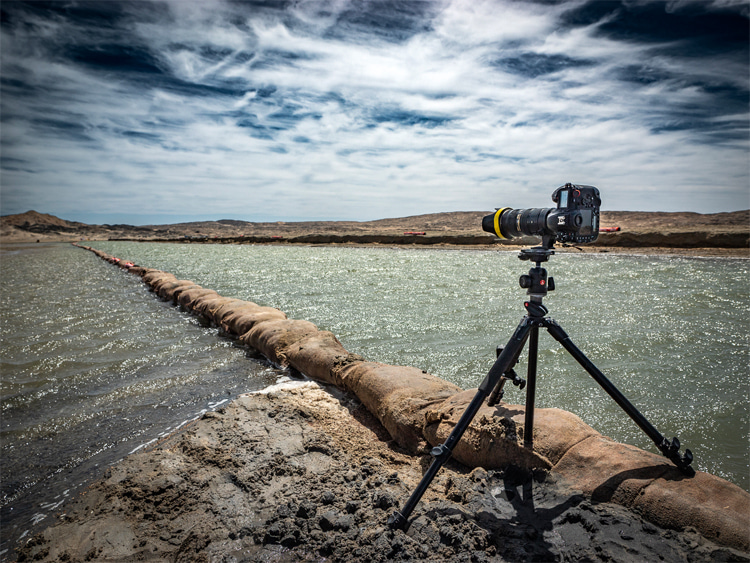
Canals
Two excellent courses exist in the south of France, taking advantage of the strong Mistral winds that blow down the Rhône valley.
Mistrals can blow at any time of the year but are more common during the winter months.
These courses are at Les Saintes Maries de la Mer and near Port St. Louis.
They are not on the open sea but in canals dredged out of the local clay and semipermanent, needing only to be repaired after storms.
Les Saintes Maries de la Mer - the course known as The Canal - near Arles has been the site of many records.
The narrowness of the channel ensures the flattest possible water for record attempts, and the wide, flat beach has few obstructions to block the wind.
The canal is about 1,100 meters (1,202 yards) long, 30 meters (32 yards) wide, and 1.5 meters (five feet) deep.
Two canals have been dug at nearby Port St. Louis, and this location may have even more potential. It should be noted that this is an industrial area.
The only drawback of canals is that moving them is not possible when the wind blows from a slightly different direction than the optimum 120-40 degrees.
There is also the famous Luderitz speed sailing canal in Namibia.
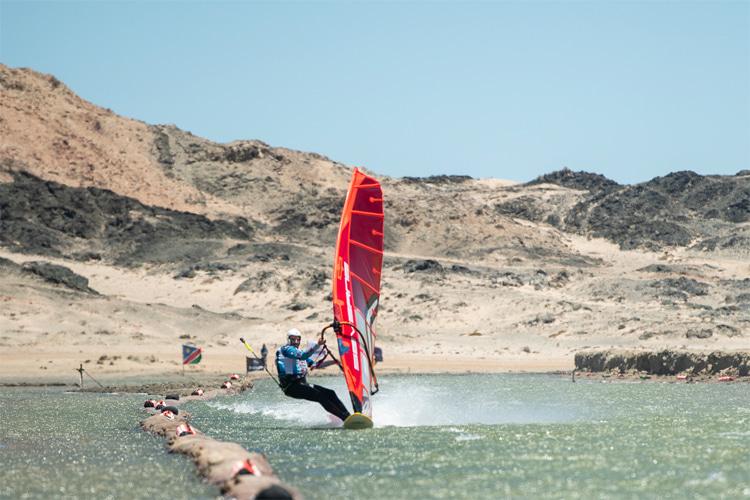
Fuerteventura, Canary Islands
Noted for strong winds in the summer months, this location is famous for speed sailing. Part of the Canary Islands chain, Fuerteventura is an island off the northwest coast of Africa.
The hot spot for speed contests is Gorriones Beach, in the south of the island at Sotavento - appropriately, this means in Spanish, "where the wind was born."
This may change if planned hotel construction goes ahead, blocking the clear passage of wind across the wide, flat beach.
Meanwhile, Gorriones is ideal for speed seekers, with the strong offshore winds providing flat water near the beach.
Being on the open sea, Gorriones may prove to be of limited use for future records as the water often gets lumpy when the wind is blowing very hard.
For speed contests where it is more important to have good competition than to set an absolute record, it is an excellent location, and there is room for many more sailors than on a canal.
Sandy Point, Australia
A long curving beach near Melbourne, Sandy Point has great potential as a world-class venue, although the curve of the beach is a problem here.
A course of 250 meters (273 yards) is easy to set up, but the curving shoreline puts sailors on a 500-meter (547 yards) course a bit further from the beach, and when the wind is blowing more than 40 knots, it is very choppy even when only 4.5 meters (15 feet) out.
Tarifa, Spain
Located less than 20 kilometers (12.4 miles) from Africa on the southern tip of Spain, Tarifa offers the steadiest winds in Europe.
The Straits of Gibraltar act as a natural wind tunnel, making this a popular speed venue. The course runs parallel to the beach and is sailed in offshore winds.
Weymouth, England
Although speed contests were a tradition at Weymouth, and many original records were set here, it is no longer used. Britain's national venue for speed sailing is now on a lake at West Kirby, Liverpool.
Speed Sailing Technique
Eric Beale offers the following advice:
"To train effectively, you have to be constantly pushing your limits."
When racing, you have to be fully powered through the lulls and hanging on with your teeth through the gusts, on the limits of blowing up."
"Then you've got the right amount of power."
"When you are out there racing against the clock, you don't have any references."
"You have to feel what's going on, using both your intuition and your intellect to decide what to use, which sail, board, and fin combination, how much weight to put on, and most importantly, when to sail."
"You could be going down the course on a record run and break the record, and a sailor at the top of the canal would have waited 45 seconds longer, and the wind behind you gets that much better, and he'll come down behind you and break it again."
"The degree with which you have to tune in on the timing of when to go gets surreal."
Starting a Speed Run
When you feel the timing is right for your start, be sure to cross the line at full speed. Avoid following too closely to the sailor in front of you.
Sailing the Course
Remember that the fastest line is not usually straight ahead - bear off in the gusts and head up in the lulls.
Look ahead for dark patches on the water and sail around them.
Do not fight the conditions but aim to let your board go with the wind as much as possible.
The ability to slide - the French say "avoir la glisse" - is a very subtle, intangible thing, and it is a feeling that may take years to acquire and hone.
Keep your board flat on the water. If you get hit by a gust while beam or broad-reaching, you might feel the nose lift.
This is slow.
Press down harder on your front foot, bear off a little but do not sheet out, and you will accelerate instead of slowing down.
Stance
The position in which you should be standing depends on your point of sail.
Whilst ideally, a speed course should be set at 120-140 degrees to the wind, this may not always be possible.
You need to learn to be fast on every point of sail.
Close Reaching
When the wind is at an angle of less than 90 degrees, you should have your pelvis parallel with the centerline of your board and most of your weight on your rear foot.
Both legs should be straight, and your shoulders twisted toward the front.
Tip
If you feel yourself pulling up against the front footstrap, it is because you have turned your pelvis forward.
Turn back towards the center again and feel your harness hook slide along the harness line as you transfer more of the pressure from the sail to your back foot.
Beam Reaching
With the wind at 90-110 degrees to your board, start to transfer more of your weight to your front foot, still keeping your pelvis parallel to the center and the sail sheeted in tight and as vertical as possible.
Both arms and legs will be almost straight if your harness lines are correctly adjusted.
Spin Out
Your legs must be kept straight to put as much pressure as possible against your fin.
If your fin starts to spin out, quickly pull the tail of the board towards you by bending your rear knee.
If you continue to have problems with spin out, try changing fins.
Broad Reaching
When broad-reaching, your rear leg will be slightly bent, and your front leg straight. You should have most of the pressure on your front foot.
The sail should still be fully sheeted in, but it will no longer be parallel to the center of the board. Having too much weight on your rear foot can make the board do a tail-walk and slow.
Catapults
You can reduce the chances of being catapulted by increasing pressure on your rear foot.
This will give you more security but does increase the chance of a spin-out.
Pulling the rig back more to the rear of the board also helps to prevent being sent flying.
Pressure Control
Speed sailing requires very subtle moves.
According to Erik Beale, "As you go downwind, you are driving more and more with your front leg, but the finer points of technique are intangibles."
"The control is so fine, and you're pushing the limit. The closest analogy is piloting a race car."
Chop
You will only be able to maintain a perfect, rock solid straight-legged, straight-armed stance if the water is very flat, on a speed canal, for example.
If you have to deal with some chop, keep both legs slightly bent to absorb the rough spots and keep you flowing over the water.
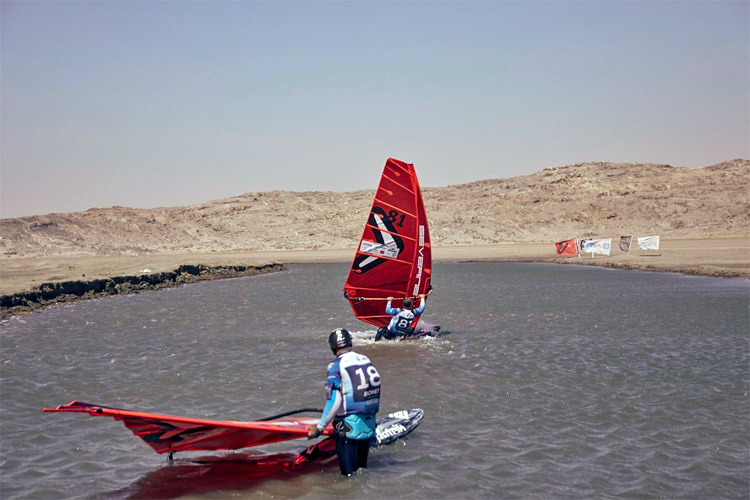
Waterstarting
As speed boards are so small, you will have to modify your normal waterstarting technique.
Place your feet near the balance point of the board.
Because the fins are also small, they do not generate lateral resistance at low speed; you have to point the board downwind and load the fin once moving.
Jibing a Speed Board
Speed boards are very narrow and designed for maximum speed, not turning. However, in order to train for speed, it is necessary to be able to jibe one.
Beach Starting
The best way to start a speed board off the beach is to leap on with the board already moving.
Training
I think that the best possible training for speed sailing is to sail as often as possible with the biggest, most powerful sail you can handle.
You need to learn to handle rough water and strong winds. When you cannot get on the water, do a lot of fitness and strength training.
A strong background in racing will teach you about sailing fast, so I suggest you enter all the races you can.
There is a lot to be learned from the best sailors in your region, and I do not recommend specializing in speed sailing without a solid general windsurfing background.
Equipment
When choosing equipment for speed sailing, the key point to bear in mind is that it should all work together.
Follow the advice of Richard Buckminster Fuller and think of synergy: "The whole is greater than the sum of its parts."
Regarding boards, Erik Beale states that "all the design elements are very important - whether it be flex, rocker, vee, rails, the thickness flow - all of these have a major effect on how the thing is going to ride."
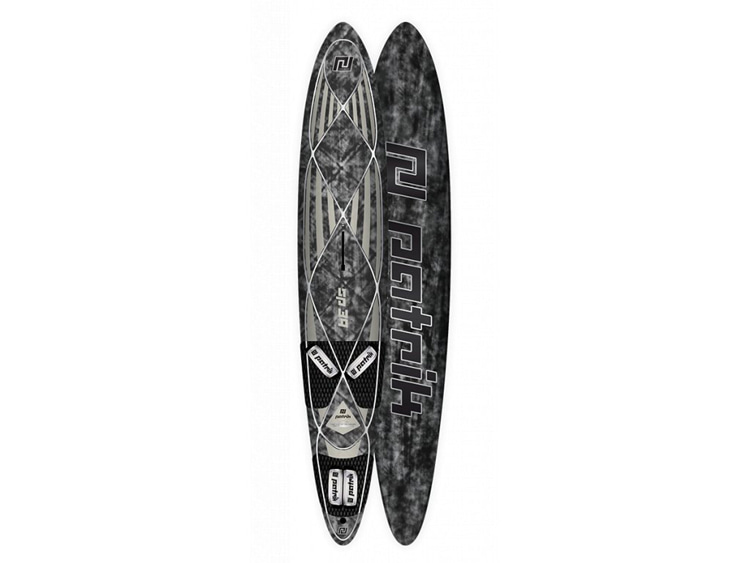
Boards
The object for a board designer is to make a board with the least amount of wetted surface and, consequently, drag.
This is achieved by making speed boards extremely small and narrow. The optimum board is also the lightest, stiffest board possible.
Erik's smallest board was 7'7'' (2.31 meters) long by 11'' (28 centimeters) at its widest point.
The tail - 12'' (30.5 centimeters) forward - was 6.5'' (16.5 centimeters) wide, and the nose (12'' back) was 6'' (15 centimeters) wide and nearly 3'' (8 centimeters) thick.
The deck and bottom of the board were almost parallel from the mast foot to the fin box, as were the rails.
This design makes that section of the board very stiff. Stiffness reduces deformation of the planing surface if it should hit some chop.
Erik was also making boards 8'12'' (2.4 meters x 30.5 centimeters), 8'3'' x 12'' (2.5 meters x 30.5 centimeters), and a fourth board 8'6'' x 16'' (2.6 meters x 41 centimeters).
Using a 5-meter (16.4 feet) sail, you can bring out a larger speed board, say 2.6 meters x 40 centimeters (8'6'' x 16''), when the wind picks up to 20 knots.
Smaller boards and sails are used in strong winds. The smallest speed sails are about 3.8-4 square meters (43 square feet).
Rocker
Similar to slalom boards, the rocker of a speed board is perhaps its most important characteristic.
Modern sails are so efficient that only the tail of the board is in the water when you are at full speed.
The rocker allows you to rock the board back on its tail as your speed increases, thus reducing wetted surface and, consequently, drag.
The Bottom Shape
Similar to the new slalom boards, speed boards are flat in the nose, going to a vee in the tail. Vee significantly increases control.
The flow of water along the bottom diverges from the centreline outwards. This keeps air away from the fin, making it more effective.
Older concave boards are very efficient at generating lift, riding very high on the surface.
They are difficult to control because there is a lot of air traveling back toward the fin.
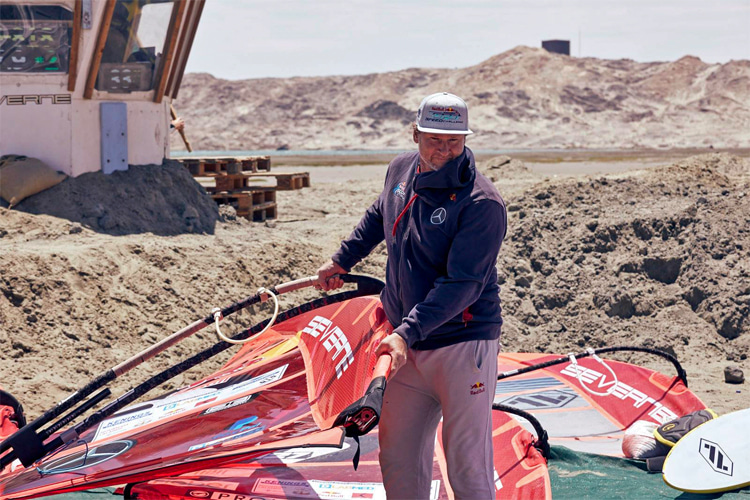
Sails
Sails are the heart of your speed equipment. They have many battens and camber inducers to lock in their profile.
A basic quiver would be three sails - 4, 4.5, and 5 square meters (43, 48, 54 square feet) - made of monofilm or other rigid sail material.
Speed sails differ considerably from slalom sails.
They have shorter booms to give them a higher aspect ratio. While slalom sails must also be fast, they must provide good acceleration at the jibe marks.
Speed sails need to generate the most amount of lift possible with no drag. The designer's priorities are top-end speed and control.
Even with the computers available to aircraft designers, wings for airplanes are still evolving.
Computer design is out there for sail designers, but the feedback will always come from real seat-of-the-pants test pilots.
The golden age of speed may be yet to come.
Here's what Erik has to say:
"Control is very important. If you have a very powerful foil section but one that stalls easily, with twitchy lift characteristics, it may be very fast over 50 meters [55 yards], but we have to average our speed over 500 meters [550 yards]."
"The ideal sail design needs to be incredibly adaptive."
"It has to be able to react instantly to a very wide range of wind speeds and angles of attack because all those things change constantly."
"The foil has to operate in a very turbulent environment, ever-changing."
"You are very close to the ground, so you are getting irregularities in speed and wind direction, even where it might be lifting slightly or descending slightly."
Wing Sails
Sailors have tried racing with so-called wing sails, rigid foils made of carbon fiber.
They found them to be very fast but too sensitive to sail easily.
As soon as their boards hit any sort of chop, the wing would shake off the laminar flow of air from the leeward side, switching off the power to the sail.
Sail Tuning
Try setting up your sail as you would for a slalom. The downhaul controls leech tension.
For broad-reaching, the sail should be set so that the leech just starts to be loose.
This helps you to bleed off excess power in gusts and keeps the center of effort down low.
The tack strap at the bottom of the sail controls the bottom of the foil.
Loosening it off will let the wind bleed off, but too much, and you will be losing power. Setting the tack strap too tight will cause the foot to stall.
The correct adjustments let you sail fully powered up in the lulls and bleed off excess power in the gusts.
Closing the Gap
Adjust your mast foot so that the foot of the sail sets parallel and close to the deck of your board.
If just the back of your sail touches the board, move your mast foot back.
If the back of the sail is too high off the board, move the mast foot forward.
Rig Adjustment
It is very important that you are in tune with your equipment - footstraps, harnesses, harness lines, boom, and sail must all be adjusted correctly.
Booms
Erik Beale says that "According to Bjorn Dunkerbeck, where you put the boom on should be irrespective of what's comfortable. You put it on there to make the sail twist a certain way."
"You might deliberately sail with your boom lower to make the sail more flexible, to have a more dynamic twist."
"If you set your booms too high, it will be difficult to water start."
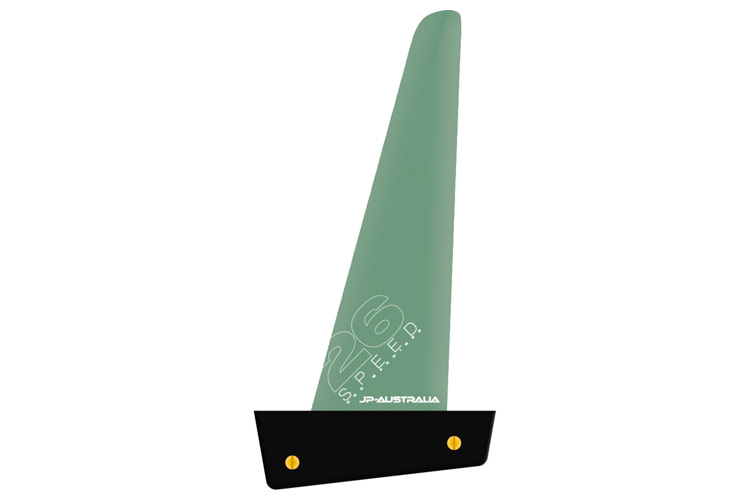
Fins
Speed fins are raked back slightly more than slalom fins.
The purpose of the rake is to prevent the leading edge from going past vertical (making the foil ineffective) should you hit some chop.
Erik's fins ranged in depth from 190-260 mm (74/210''), and he had different sizes every 15 mm (5/16'') in between.
"Fins are the reflection of the sail underwater," added Beale.
"Because water is so much denser than air, the fin needs to be considerably smaller than the sail."
"Both the size of the fin and its foil section have an effect."
"A point to consider is the angle of attack of the fin, its path through the water. The ideal angle is about 4 degrees."
"A very thin foil section is theoretically faster but is going to need a greater angle of attack to generate lift, which can create more drag."
"Most of my fins are around 10 percent foils, as are my sails. In 1988, most people were using foils of about 12 percent."
"If you use a narrower foil, it has to be slightly deeper. The thickest point is 50 percent back."
"Having both the leading and trailing edges curving - an elliptical shape - allows you to foil a better fin."
"The tip vortexes are bled off, effectively generating less turbulence."
"I make my fins as rigid as possible through the bottom two-thirds; if the tip is slightly flexible, it might give you a little more user-friendliness."
Tuttle boxes are the most effective method of attaching fins to a board.
Do not use too small a fin at first - 23-25 centimeters (9-10'') of depth would be a good size to start with.
If the wind is really strong, you can use smaller fins, 18-20 centimeters (7-8'') long, but remember that too small a fin will make waterstarting and sailing back upwind more difficult.
Some racers use asymmetrical fins.
Pascal Maka used a 220 mm (8'') asymmetrical Curtis fin when he set the record at 42.91 knots.
The choice is ultimately up to the racer. Try a variety of fins and see what works best for you.
Harnesses
A seat harness is essential.
It will help keep your center of gravity low, giving you more power than a waist or chest harness.
Harness lines can be set closer together than on a slalom sail, as speed sails have shorter booms.
When setting harness lines, start with them forward to make a catapult less likely.
Then, gradually move them back until you find the most balanced position.
Tips
- If control is a problem, try lowering your booms or using a different fin. If you feel that your equipment is not adjusted properly, do something about it, go back to the beach, and fix it. Use a waterproof marker to mark the ideal settings for your booms and mast base;
- Avoid setting your sail too full because the apparent wind is so far forward a flatter sail is required. A fuller sail will give you better acceleration, but at maximum speed, it will create drag. Speed sails are designed to be rigged with a lot of downhaul tension. This locks in the draft and makes the sail more predictable and easier to handle in strong winds;
Weight Jackets
Like slalom racers, many speed sailors use weight jackets to help them hold down a larger sail size.
These use lead or water for weight, although lead is more aerodynamic. Make sure that your jacket still offers positive buoyancy.
Organizing a Speed Trial
It is complicated to organize a world record attempt and requires the help of the WSSRC, but running a speed trial event for fun is well within the capabilities of small windsurfing clubs or other organizations.
The ideal location would be a sandy spit with unobstructed wind where transit marks can be easily set up.
Timing
The simplest method is to set up a speed trap with a borrowed radar gun. However, these can be difficult to time accurately with.
Another way to set up a small trial is to find a measured distance on the water and time sailors over the distance with a stopwatch.
If you do not have a surveyor's transit handy for measuring the distance between two buoys, check your local chart.
You may find two conveniently located channel markers or other fixed buoys. Or perhaps you could use land-based transits along the harbor wall or beach.
Short Courses
It is not necessary for a course to be the official length of 500 meters (547 yards) for sailors to have fun.
A shorter course of 250 meters (273 yards) will be easier to organize and provide sailors with more runs.
Take note - it only takes 24.33 seconds to cover 500 meters at 40 knots.
With fast sailors, it will be difficult to time accurately on a course of less than 250 meters using stopwatches, so GPS devices are always the best option.
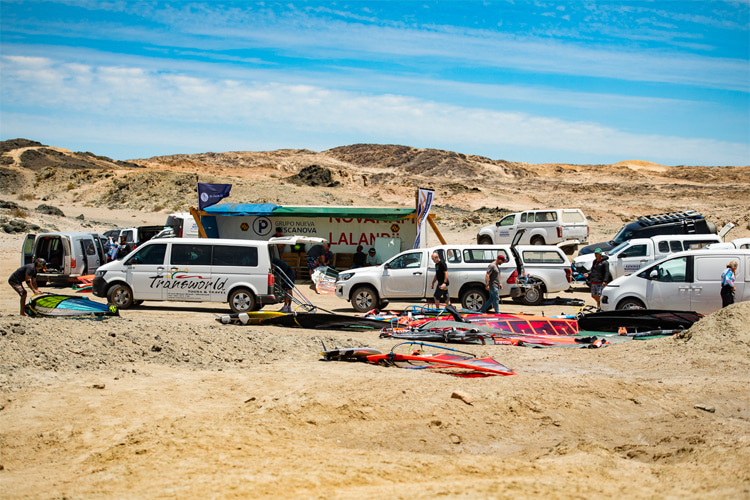
Course Layout
Your course need not be set at the optimum angle of 120-140 degrees off the wind, but sailors will achieve higher speeds at that angle.
If you are organizing a contest where less experienced sailors may be taking part, consider setting a course closer to 90 degrees to the wind.
Sailors will not be traveling at their highest possible speed, but you will be less likely to lose them downwind, unable to return in time for another run.
Try to set up your speed course in an area that is free of obstructions, both on the water and on the land.
A clean run-up for the wind will give a fairer chance to all sailors.
At the Sotavento course, the wind has a fetch of more than one kilometer (0.62 miles) before blowing offshore, which is one of the reasons why it is such a good location for speed trials.
Safety
Offshore winds are most conducive to speed, as they provide the flattest water.
Remember to have some kind of rescue boat available to help sailors who break down.
In many areas, the spring and fall equinoxes provide the strongest winds but do not forget wind chill as a factor hypothermia is a real threat in these conditions.
Apparent Wind
The wind felt by your sail is called apparent wind.
It is a combination of the speed of the true wind and the wind that you create from your motion through the water.
It is this apparent wind that makes it possible to sail faster than the true wind.
Antoine Albeau is the fastest windsurfer in the world. The French windsurfer locked in 53.27 knots in Luderitz, Namibia.
This speed is equal to 98.65 kilometers per hour (61.30 miles per hour), or 27.40 meters per second.
Who knows when somebody will sail 60 knots? However, you can bet it will take a lot of wind and a well-prepared sailor.
Words by Rob Reichenfeld | Windsurfer and Author of "Windsurfing: Step by Step to Success"
